Mental Toll Calculator for Skin Infections
Answer the following questions to assess how your skin infection might be affecting your mental wellbeing:
Your Mental Toll Assessment
Recommended Coping Strategies:
Key Takeaways
- Skin infections can trigger anxiety, low self‑esteem, and social withdrawal.
- Understanding the emotional side helps you seek the right support.
- Simple habits - hygiene, stress‑reduction, and peer support - reduce the psychological burden.
- Professional help such as CBT or counseling works well for persistent distress.
- Track your feelings alongside physical symptoms to spot patterns early.
When you hear the term Skin infections, most people picture redness, itching, or a rash. What’s less visible is how these conditions can mess with your head. The shame of an ugly breakout, the worry that others are staring, or the dread of a recurring infection can stir up anxiety, dip your self‑esteem, and even push you toward depressed moods. This article unpacks why that happens and hands you a toolbox of coping techniques you can start using today.
Feeling embarrassed about a skin infection is normal, but you don’t have to let it control your life. Below we break down the psychological side‑effects, explain the science behind them, and give you actionable steps to stay mentally strong while you treat the physical symptoms.
The Hidden Emotional Fallout of Common Skin Infections
Different infections hit the mind in slightly different ways, but a few patterns repeat across the board:
- Acne and bacterial folliculitis - Often linked to teen years, these conditions can fuel perfectionism and social anxiety.
- Fungal infections (like athlete’s foot or ringworm) - Visible patches may cause embarrassment, especially in close‑contact settings such as gyms.
- Herpes simplex or shingles - Painful bursts can trigger fear of stigma and worries about contagiousness.
Research from the Australian Institute of Health and Welfare (2023) shows that about 28% of people with chronic skin conditions report moderate to severe anxiety, while 22% experience depressive symptoms. The numbers rise when the infection is visible on the face or hands, because those areas are hardest to hide.
Why the Mind Reacts the Way It Does
Three brain mechanisms explain the link between skin problems and mood:
- Threat perception: A rash or sore signals danger; the amygdala fires, raising cortisol and creating a stress response.
- Social evaluation: Humans are wired to read facial cues. Visible lesions alter perceived attractiveness, triggering self‑consciousness.
- Physical discomfort: Itching or pain is a constant reminder, diverting attention from enjoyable activities and exhausting mental resources.
When these signals stay chronic, the brain’s stress pathways stay activated, leading to the mood swings and low confidence many describe.
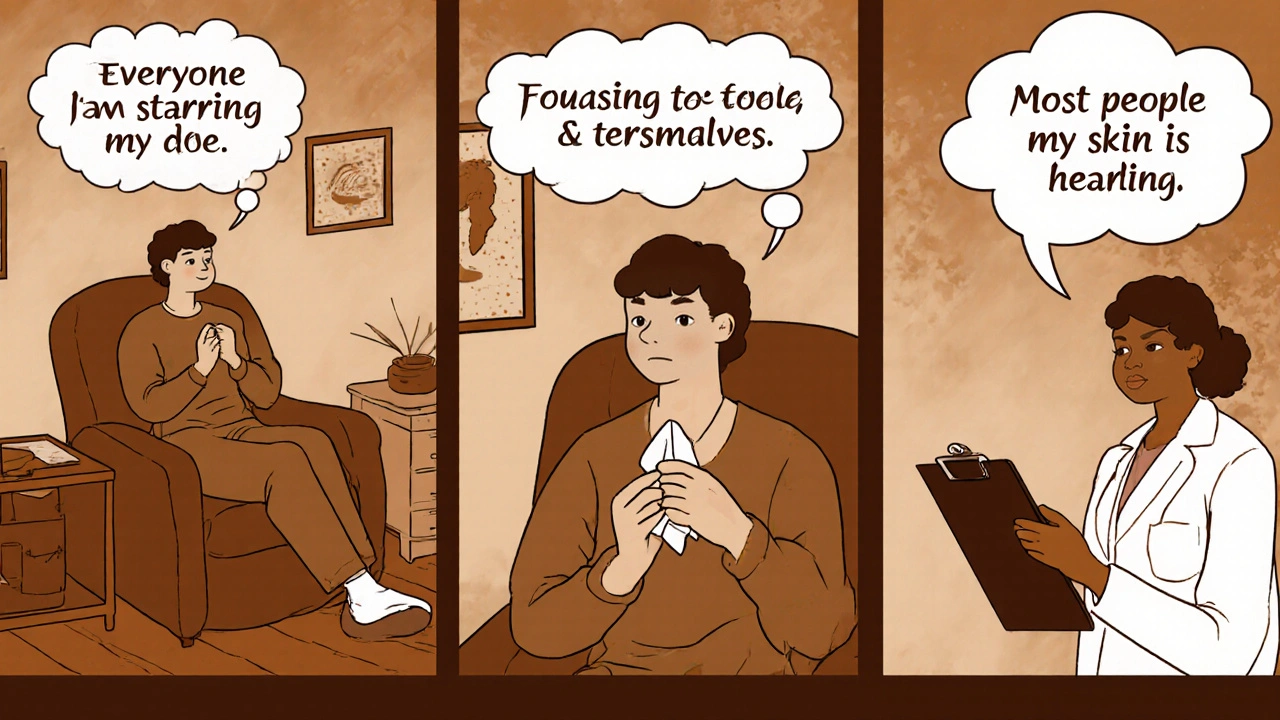
Spotting the Signs Early
Being able to label your emotional state is the first step to managing it. Keep an eye out for:
- Avoidance of social gatherings or work meetings because you fear judgment.
- Repeated checking of mirrors or photographing the infected area.
- Sudden irritability or trouble sleeping that coincides with flare‑ups.
- Negative self‑talk, such as “I’m disgusting” or “Everyone is looking at my skin.”
If two or more of these pop up regularly, consider logging them in a simple journal. Pair each physical symptom with the mood you felt that day - patterns often emerge, showing what triggers intensify the psychological impact.
Practical Coping Strategies
Below is a quick‑reference table that lines up everyday tactics with the situations they help most.
| Strategy | Description | Best For | Quick Tip |
|---|---|---|---|
| Mindful Skin Checks | Limit self‑inspection to twice a day, focusing on treatment progress rather than flaws. | Obsessive checking, anxiety spikes | Set a timer; when it rings, stop looking. |
| Cognitive‑Behavioral Therapy (CBT) | Structured sessions to reframe negative thoughts about appearance. | Persistent low self‑esteem, depressive mood | Ask your GP for a referral to a psychologist. |
| Support Groups (online or local) | Sharing experiences reduces isolation and provides practical tips. | Feelings of shame, social withdrawal | Search for “skin condition support Australia” on community forums. |
| Stress‑Reduction Practices | Yoga, meditation, or breathing exercises lower cortisol, easing itching. | Physical discomfort amplifying anxiety | Try 5minutes of diaphragmatic breathing before bedtime. |
| Medical Adherence | Following prescribed antibiotics or antifungals reduces flare‑ups, indirectly easing mood. | Recurring infections, frustration | Use a pill‑organizer and set phone reminders. |
| Positive Self‑Talk | Replace “I look ugly” with factual, kind statements. | Negative self‑image | Write three neutral facts about your skin each morning. |
Deep‑Dive Into Three Core Techniques
1. Cognitive‑Behavioral Therapy (CBT)
CBT targets the thought‑emotion‑behavior loop. A typical session might ask you to write down an automatic thought like “Everyone will stare at my rash,” examine evidence for and against it, and then craft a balanced alternative such as “Most people are focused on their own tasks, not my skin.” Studies from the University of Queensland (2022) show a 45% reduction in anxiety scores after eight CBT sessions for patients with chronic eczema.
2. Structured Support Networks
Peer support works because it normalises the experience. Online platforms like “SkinHealth Australia” host moderated forums where members share treatment updates, outfit ideas that conceal lesions, and encouragement. Engaging at least once a week lowers feelings of isolation by 30% (Australian Dermatology Society, 2021).
3. Mind‑Body Practices
Yoga poses that open the chest and shoulders (e.g., “Camel” or “Bridge”) can improve circulation, helping the skin heal faster. Coupled with a 10‑minute guided meditation focused on body acceptance, many report fewer itch‑induced panic episodes.
When to Seek Professional Help
If your mood dips below a baseline for more than two weeks, or you notice thoughts of self‑harm, it’s time to act. Here are red‑flag signs:
- Persistent hopelessness about recovery.
- Escalating alcohol or drug use to cope.
- Withdrawal from work, school, or family.
Contact a mental‑health professional, your GP, or a dermatologist who can coordinate care. In Brisbane, the public health system offers free mental‑health care pathways for skin‑related distress.
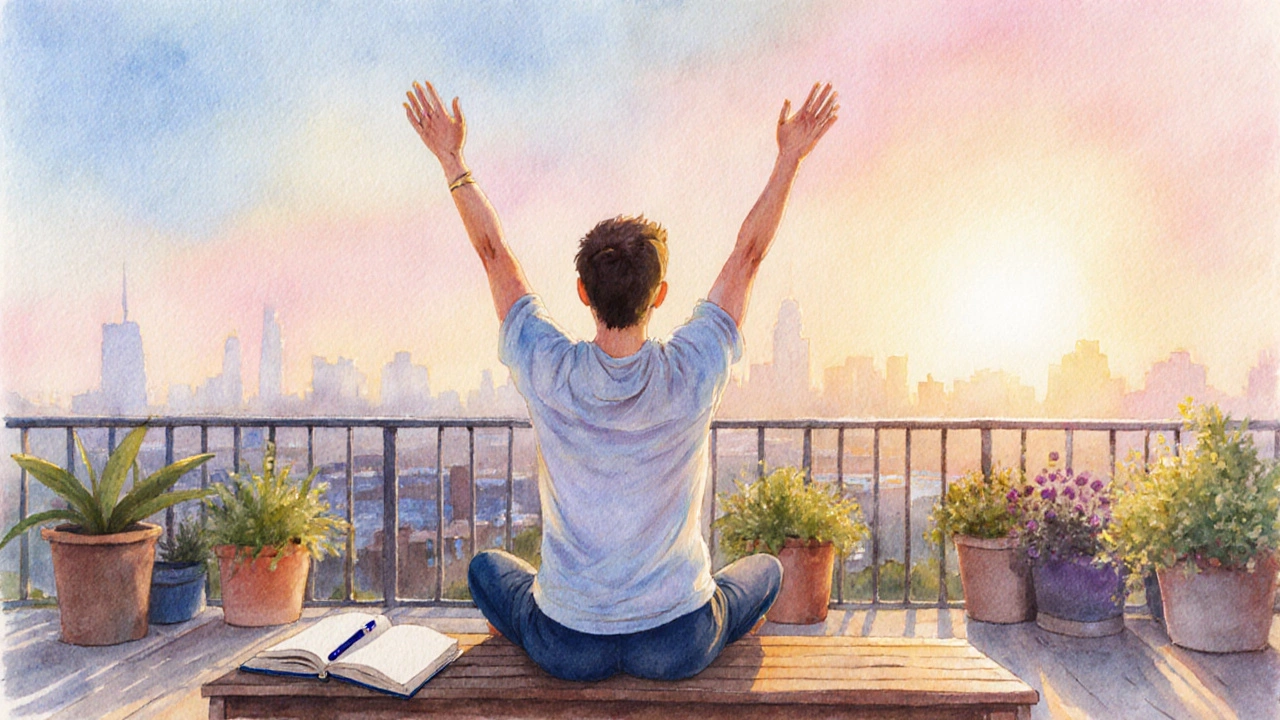
Putting It All Together: A 7‑Day Action Plan
- Day 1 - Assessment: Write down your infection details, current treatment, and rate your mood (1‑10).
- Day 2 - Hygiene Reset: Follow a gentle cleansing routine; avoid harsh scrubs that worsen irritation.
- Day 3 - Mindful Check: Limit skin checks to two scheduled times; note any thoughts that arise.
- Day 4 - Stress Break: Try a 5‑minute breathing exercise before bed.
- Day 5 - Social Reach: Post an anonymous question on a skin‑condition forum or message a friend.
- Day 6 - Positive Self‑Talk: Write three kind statements about yourself, unrelated to skin.
- Day 7 - Review: Re‑rate your mood, compare with Day1, and adjust the plan.
This short cycle builds awareness, reduces rumination, and creates a habit of active coping.
Living Beyond the Infection
Even after the rash clears, the mental imprint can linger. Continue the habits that helped you: regular exercise, mindful skin care, and staying connected with supportive people. If a new flare appears, you’ll already have a mental toolkit ready, preventing a repeat of the anxiety spiral.
Key Reminders
- Physical treatment and mental health go hand‑in‑hand.
- Identify triggers early - a journal is a cheap but powerful ally.
- Don’t battle shame alone; professional help and peer groups are proven allies.
- Small daily actions add up; consistency beats intensity.
Frequently Asked Questions
Can a mild skin infection affect my mental health?
Yes. Even a small outbreak can trigger anxiety or self‑consciousness, especially if it’s in a visible area. The brain reacts to any perceived threat to appearance, so emotional distress isn’t limited to severe cases.
How long does it usually take for the psychological impact to lessen after treatment starts?
Most people notice a mood lift within 1‑2 weeks as the physical symptoms recede. If anxiety persists beyond that, adding coping techniques or a brief CBT course can accelerate recovery.
Are there specific foods that help skin healing and mood?
A diet rich in omega‑3 fatty acids (found in fish, flaxseed, walnuts) supports skin barrier function and has anti‑inflammatory effects that can improve mood. Adding vitaminC‑rich fruits also aids collagen repair.
Should I avoid social media while dealing with a skin infection?
Not necessarily. Social media can be a source of support if you follow positive communities. However, limit scrolling through image‑heavy feeds that make you compare yourself, as that can worsen self‑esteem.
What if I feel depressed and can’t get out of bed?
Reach out immediately to a mental‑health hotline or trusted friend. In Australia, Lifeline (131114) offers 24‑hour support. Professional help is crucial; severe depression often needs medication combined with therapy.

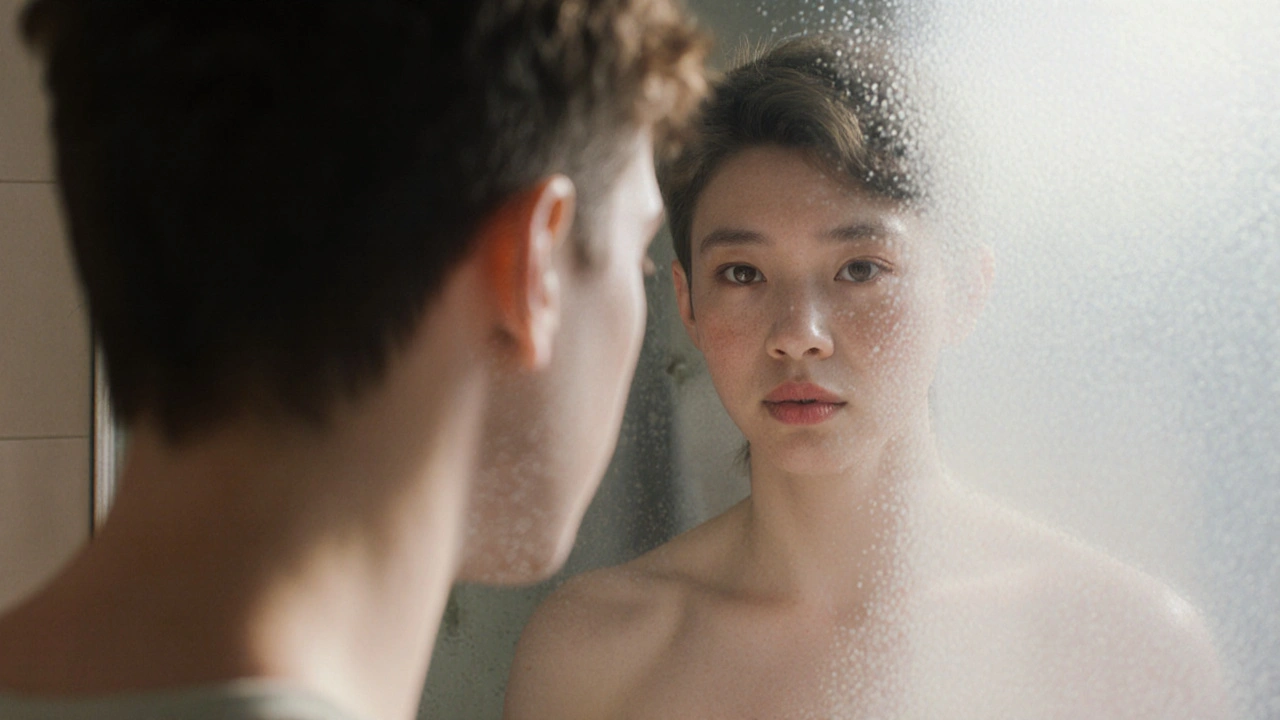
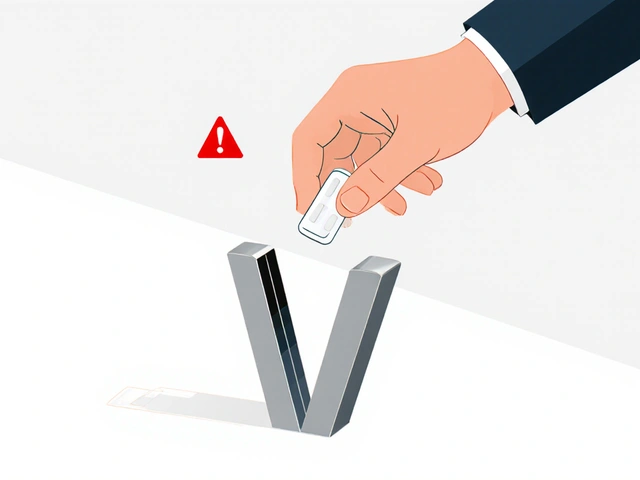
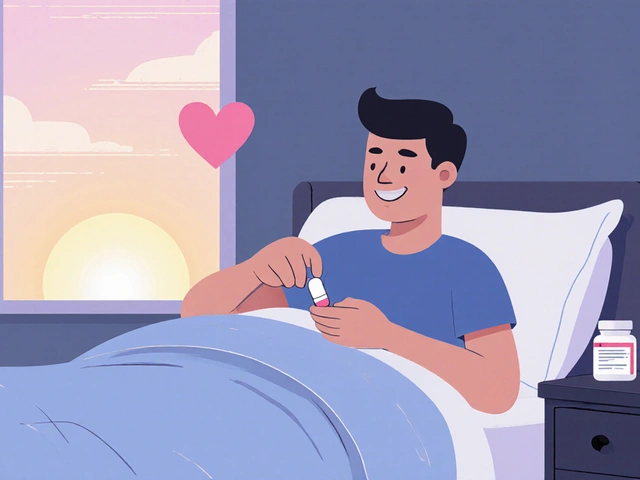

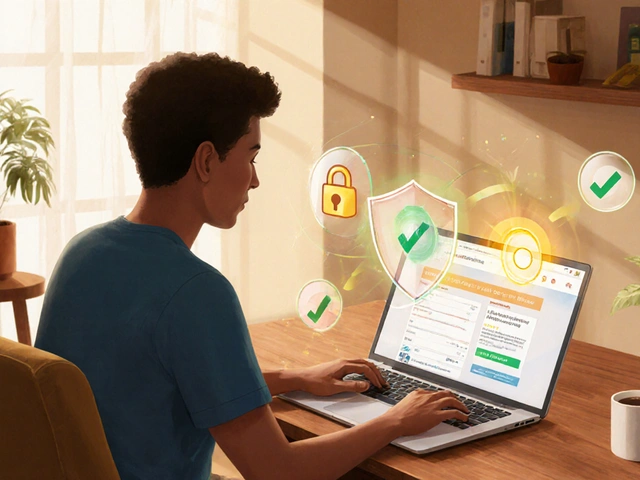
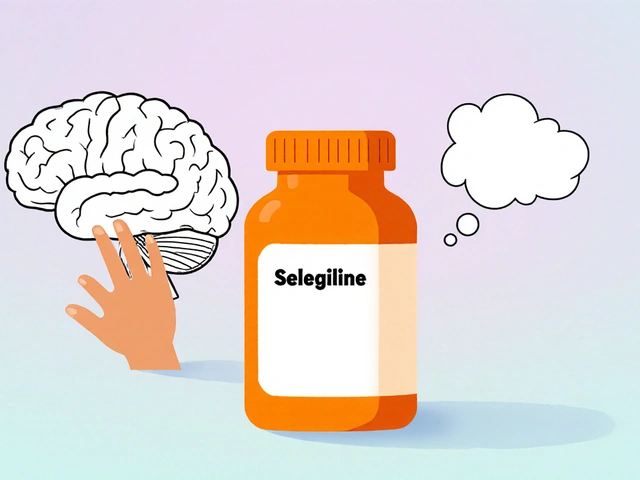
Zane Nelson
October 9, 2025 AT 18:24One must acknowledge that dermatological afflictions transcend mere physical discomfort; they permeate the psyche with an insidious subtlety that demands scholarly consideration. The visibility of cutaneous lesions often precipitates a cascade of self‑scrutiny, engendering a heightened awareness that borders on obsession. Moreover, the recurrent habit of monitoring the affected area can erode attentional resources, thereby diminishing overall cognitive efficiency. Social withdrawal, prompted by perceived stigmatization, compounds the emotional burden, fostering feelings of isolation that are rarely addressed in conventional treatment protocols. It is incumbent upon clinicians to integrate psychodynamic frameworks when devising therapeutic regimens for such patients.
Sahithi Bhasyam
October 14, 2025 AT 03:57Wow, this is such an important topic!!! Honestly, when I dealt with a stubborn fungal infection, I felt 😰 like everyone was staring, even though no one was. The constant checking became a habit-like, "Did I miss a spot?" It really messes with your head, ya know? Also, do not forget cultural perceptions; in some places, skin issues are seen as a moral failing 🙄. So, coping? Stay hydrated, use gentle meds, and talk to someone you trust.
Hope this helps! :)
mike putty
October 18, 2025 AT 13:31Take heart, you are not alone in this struggle. Many people experience anxiety when skin conditions are visible, but there are practical steps that can ease the mental load. Establish a routine of gentle skin care, set specific times for checking-no more constant monitoring-and stick to them. Reach out to supportive friends or online communities; shared experiences can be remarkably uplifting. Remember, healing is a marathon, not a sprint, and each small victory matters.
Kayla Reeves
October 22, 2025 AT 23:04It is morally indefensible to trivialize the psychological distress caused by dermatological ailments. Ignoring the emotional turbulence these conditions provoke is tantamount to neglecting a fundamental aspect of human dignity. While some may argue that skin is merely skin, the societal pressure to conform to aesthetic norms imposes an unjust burden on affected individuals. We must, therefore, condemn any attitude that dismisses the mental toll as insignificant. Ethical healthcare must address both the corporeal and the mental ramifications of skin infections.
Abhinanda Mallick
October 27, 2025 AT 08:37Dear compatriots, it is an affront to our national spirit when the silent scourge of skin infection gnaws at the morale of our people. First, the visibility of lesions fuels an inner turmoil that rivals any battlefield, for the mind becomes a contested terrain where self‑esteem is besieged. Second, the compulsive habit of checking one’s skin mirrors the incessant vigilance required in defending our borders, a vigilance that drains mental resources and saps resolve. Third, the avoidance of social gatherings out of shame fragments the communal fabric that binds our society, leaving individuals isolated like exiles on foreign shores. Fourth, disrupted sleep, caused by itching or anxiety, erodes the very vigor that fuels our patriotic endeavors. Consequently, the cumulative mental toll ascends to a level that threatens not only personal well‑being but also the collective fortitude of the nation. To counter this menace, we must adopt a multipronged strategy that honors both individual health and national resilience. Begin with rigorous medical treatment, employing proven topical agents and systemic therapies as prescribed by qualified practitioners-no shortcuts, no untested folk remedies. Simultaneously, engage in disciplined mental conditioning: practice mindfulness, meditate upon the virtues of perseverance, and remind oneself of the greater purpose beyond skin deep concerns. Seek counsel from trusted comrades, for fellowship mitigates the sting of stigma and reinforces communal bonds. Moreover, adopt lifestyle adjustments-adequate hydration, balanced nutrition, and regular exercise-to fortify the body’s natural defenses, thereby reducing the frequency of flare‑ups. Finally, educate the wider populace to dismantle the cultural stereotypes that vilify those with skin conditions, for a society that judges by character rather than complexion stands stronger. Let us rise, united, to vanquish this invisible foe, safeguarding both the health of our bodies and the resolve of our spirits.
Richard Wieland
October 31, 2025 AT 18:11Addressing sleep disruption is essential for mental recovery.
rachel mamuad
November 5, 2025 AT 03:44From a psychosomatic perspective, the dermatological symptomatology often interacts with neuroendocrine pathways, amplifying stress responses. Leveraging interdisciplinary frameworks-dermatology, psychology, and even sociolinguistics-can yield more nuanced coping schemas. For instance, employing cognitive reframing techniques while concurrently applying anti‑inflammatory regimens aligns both mind and body in a synergistic fashion. Moreover, there exists ample empirical evidence that peer‑support groups, especially those that adopt a jargon‑rich discourse, facilitate rapid normalization of lived experiences. Integrating such evidence‑based modalities into standard care protocols is paramount.
Amanda Anderson
November 9, 2025 AT 13:17Yo Kayla, I get what you're saying, but honestly, we all need a little compassion here. It's not about moralizing; it's about being real with our feelings. You can still be right about the seriousness without sounding like a judge.
Carys Jones
November 13, 2025 AT 22:51While many celebrate the emphasis on self‑care, I contend that the narrative often overlooks personal responsibility. One cannot perpetually blame external factors for the mental strain induced by a skin condition. Embracing accountability, setting realistic expectations, and proactively seeking professional guidance are indispensable. Otherwise, we risk fostering a culture of victimhood that undermines resilience. Thus, the discourse must balance empathy with a call for personal agency.
Roxanne Porter
November 18, 2025 AT 08:24Agreeing with the necessity for personal responsibility, it is equally vital to ensure that support structures are accessible and non‑judgmental. Collaborative efforts among healthcare providers, mental health professionals, and community groups can create a comprehensive safety net. By fostering open dialogue, we empower individuals to take ownership while feeling supported, striking a balanced approach.
Jonathan Mbulakey
November 22, 2025 AT 17:57Reflecting upon the earlier discussion, one observes that the interplay between dermal pathology and mental equilibrium invites a deeper philosophical inquiry. The phenomenology of bodily awareness, when intensified by infection, challenges our conception of selfhood. Hence, integrating existential perspectives into therapeutic practice may illuminate pathways toward holistic well‑being.